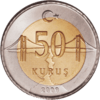Kuruş
The kuruş (pl. kuruşlar) is a Turkish currency subunit. Since 2005, one Turkish lira is equal to 100 kuruş. The kuruş, better known as the piastre, was also the standard unit of currency in the Ottoman Empire up to 1844 and the subdivision of the former lira from then until the 1970s. It was subdivided into 40 para or 120 akçe.
Name
The Turkish word kuruş (Ottoman Turkish: قروش, kurûş; Greek: γρόσι, grosi or grosha)[1] is derived from the French gros ("heavy"). It is cognate with the German groschen and Hungarian garas.
The name piastre or piaster derives from the Italian piastra.
History

The kuruş was introduced in 1688. It was initially a large, silver coin, approximately equal to the French écu, or, from other sources, to the Spanish dollar. However, during the 18th and early 19th centuries, debasement reduced the kuruş to a billon coin weighing less than 3 grams.
At the beginning of the 19th century, silver coins were in circulation for 1 akçe, 1, 5, 10 and 20 para, 1, 2 and 2½ kuruş, together with gold coins denominated in zeri mahbub and altin. As the silver coins were debased, other denominations appeared: 30 para, 1½, 3, 5 and 6 kuruş. The final coinage issued before the currency reform consisted of billon 1, 10 and 20 para, and silver 1½, 3 and 6 kuruş.
In 1844, the Turkish gold lira was introduced as the new standard denomination. It was divided into 100 silver kuruş and the kuruş continued to circulate until the 1970s.
Kuruş eventually became obsolete due to the chronic inflation in Turkey in the late 1970s. A currency reform on 1 January 2005 provided its return as the 1/100th of the new lira.
See also
References
Citations
Bibliography
- Krause, Chester L.; Clifford Mishler (1991). Standard Catalog of World Coins: 1801–1991 (18th ed.). Krause Publications. ISBN 0873411501.
External links
- http://www.osmanliparalari.com Everything about Ottoman coins (in Turkish)
- 50 Kuruş Banknote